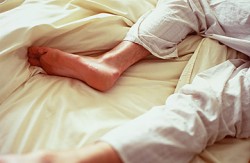Restless Leg Syndrome
Restless leg syndrome is a disorder that causes you to feel an urgent need to move your legs to stop or unwanted or unpleasant sensations (usually while resting). This syndrome is most commonly observed in the lower limbs but is also known to affect the upper limbs, the torso and also the phantom limbs. You feel a sense of temporary relief upon moving the part of the body that is affected because movement modulates and regulates the sensation.
The syndrome is associated with unwanted tickling, twitching or itching of the muscles of the affected limbs. It is described as ‘an itch that cannot be scratched’ or persistent tickling sensation. These sensations can develop spontaneously usually during the waking hours when you are resting or relaxing, studying or even trying to sleep. If you suffer from restless leg syndrome, you may experience involuntary jerking movements of the legs or the affected limbs during sleep, which is a positive indicator of the presence of a psychological disorder and may be related to disruption of sleep.
Possible Causes, Incidence and Risk Factors:
Restless leg syndrome usually manifests during middle or older age. The presence of stress can aggravate the condition and continue to worsen it over time. The cause of the syndrome remains unknown.
Conditions that may contribute to the development of restless leg syndrome include:
- Iron Deficiency Disorders
- Diabetes Mellitus
- Chronic Renal Disease or Dysfunction
- Pregnancy
- Peripheral Neuropathy
- Parkinsonism
- Certain Drugs or Chemical Substances (such as neuroleptics, caffeine, lithium and calcium channel blockers)
- Drug Withdrawal Syndrome
 This syndrome is classified as an inherited disease. This is an important factor when the manifestations of the disease are seen in younger ages, although the gene that is associated to the development of the syndrome has not been identified yet. Restless leg syndrome can disrupt sleeping patterns and routines which can lead to insomnia. These disrupted sleeping patterns can cause drowsiness and sleepiness during the daytime and possibly lead to depression, confusion, anxiety and/or slow thinking and perception.
This syndrome is classified as an inherited disease. This is an important factor when the manifestations of the disease are seen in younger ages, although the gene that is associated to the development of the syndrome has not been identified yet. Restless leg syndrome can disrupt sleeping patterns and routines which can lead to insomnia. These disrupted sleeping patterns can cause drowsiness and sleepiness during the daytime and possibly lead to depression, confusion, anxiety and/or slow thinking and perception.
Warning Signs:
This syndrome can trigger abnormal sensations that can be felt in the lower limbs in the region between the ankle and knees. These sensations tend to make the patient irritable and uncomfortable.
Facts regarding these sensations are listed below:
- They generally occur at night, or when you are resting, relaxing, trying to sleep or lying down.
- They are associated with feelings of tingling, itching, tickling, creeping, crawling, searing, aching or pulling.
- They can last for an hour or more a day.
- They may also manifest in your feet, upper limbs and/or the upper portion of your legs.
While you feel an overwhelming urge to move the affected limb or walk in order to stop the sensations; these actions only provide temporary relief. All forms of this syndrome are known to affect the sleeping patterns. The onset of the sensations can worsen in the presence of an emotional upheaval or stress. Warning signs also may include: a lack of attention or concentration during normal activities such as driving a car or attending a meeting.
Treatments:
Restless leg syndrome needs to be treated by isolating the cause of the symptoms. This condition is linked to several mental illnesses. If the cause is peripheral neuropathy (nerve inflammation or damage), the appropriate treatment is exercise, physiotherapy and/or massages. If no cause is determined then your stress levels are monitored and you are taught relaxation techniques. People who have restless leg syndrome tend to experience high levels of stress.
Methods of Relief:
Shaking the legs and stretching the muscles of the legs usually can bring some sort of temporary relief as well as walking. You indulge in some sort of movement of the legs in order to get relief. Your symptoms return as soon as the movement stops.
Common tips that help with the condition are:
- Cold or Hot Showers
- Sexual Intercourse
- Massages
- Exercise
Iron Supplements:
People who suffer from restless leg syndrome should get their blood iron levels checked. Your iron level should around 50 µg/L. You physician may prescribe oral iron supplements to increase the levels of ferritin (iron) in your body. Sometimes even a level of 50 µg/L is not sufficient for some people and this has to be increased to 80µg/L. Around 60% of individuals with this disorder find relief with an iron level 80µg/L.
Prevention:
Techniques that help relax you and reduce your stress level may reduce the severity of the syndrome.
References:
Daroff, R. B. (2012). Bradley’s neurology in clinical practice (5th ed.)Retrieved from http://books.google.com/
Drislane, F. (2006). Blueprints neurology. Retrieved from http://books.google.com/.
Other movement disorders: Lang AE. In: Schafer AI, Goldman L, Cecil Medicine, 24th edition.





